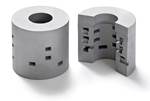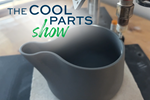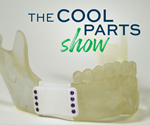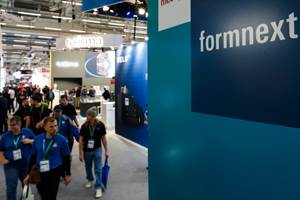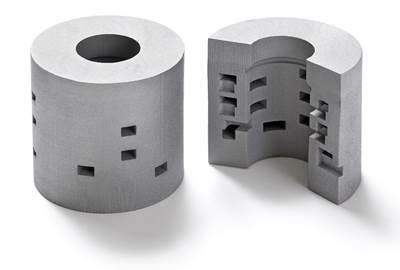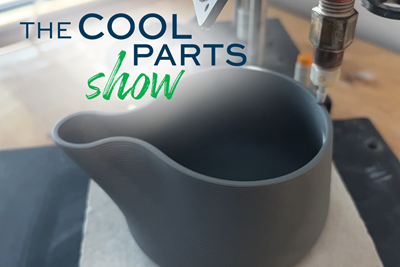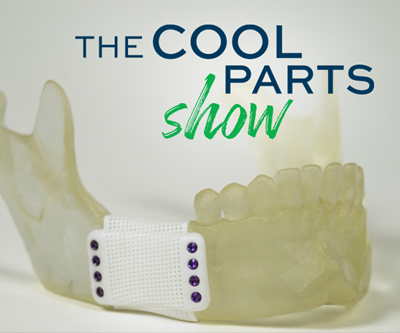Ceramics are powerful materials — they are resistant to wear, heat, chemicals and electrical conduction, so why don't we use them more? Answer: They can be hard to work with in manufacturing, in many cases requiring specialized molding processes combined with machining only through fine grinding. But 3D printing is changing this, introducing comparatively easy modes for making ceramic parts and products. On this episode of AM Radio, Julia Hider and I discuss various possibilities and applications for additive manufacturing with ceramics.
Transcript
Peter Zelinski
Part of the design freedom of additive manufacturing is new possibilities for hard materials that aren't metal. 3D printing of ceramics on this episode of AM Radio. And bonus, once we start talking about that, that leads us into a separate conversation about casting and additive manufacturing competing with one another.
Stephanie Hendrixson
The AM Radio podcast is brought to you by The Cool Parts Show, a video series dedicated to highlighting unique, unusual and innovative 3D printed parts. Watch episodes at TheCoolPartsShow.com.
Peter Zelinski
I’m Pete Zelinski, welcome to AM Radio, the podcast where we tune in to what's happening with additive manufacturing. I am joined by my colleague Julia Hider.
Julia Hider
Hey, Pete.
Peter Zelinski
Hey, Julia. So, I think I want to talk about materials. I think we can kind of agree like a big, big part of what additive is all about, the promise it brings is material freedom.
Julia Hider
Yeah, I totally agree with that.
Peter Zelinski
And what I've been thinking about lately is ceramics, new possibilities, that additive brings for ceramics.
Julia Hider
Yeah, this is something that I'm seeing as well. But before we get into the 3D printing of it, I think we should take a minute to define what ceramics are. Because before I started writing about manufacturing, when I thought of ceramics, I’d just think about mugs and figurines.
Peter Zelinski
Hummel figurines.
Julia Hider
Yes, yeah. And that's part of it. But there's a whole lot more to it than that.
Peter Zelinski
Ceramic. Yeah, that's this term. Like everybody's kind of got a sense of what they think it is. But what is the actual circle that ceramics contains? And that term actually contains a lot. So ceramics, they're, they're non-metallic materials. They are very hard, so hard that processing is a challenge. And I think we'll talk about that. But ceramics, non-metallic materials that hold their properties very well, mechanical properties such as hardness, chemical resistance, electrical non-conductivity, thermal resistance, like high, high heat applications. There's a whole lot of types of ceramics, but they're materials that sort of fit that category.
Julia Hider
All right, yeah, I'm with you so far.
Peter Zelinski
So let me tell you how we started thinking about this. So quite a while ago, I wrote an article involving Deka Research. And they were they were using laser powder bed fusion to make this part out of this alloy called MAR-M247. Does that ring a bell?
Julia Hider
No, I'm not super familiar with that material.
Peter Zelinski
Like right? Me neither. So very, it's a nickel-based alloy, very familiar with nickel-based alloy like that, like Inconel and that family of materials comes right to mind. But I have written largely about machining, we tend to encounter in manufacturing, the nickel-based alloys that are easy-ish to machine. MAR-M247, is not that. And so applications are really limited. But the thing about 3D printing is near, near, near, near, net shape, manufacturing. So the amount of machining needed is potentially very slight. And it opens the door to these greater possibilities for these alloys that are difficult to machine. But that idea goes farther. Like it also brings new possibilities for things that aren't metal that are even more challenging to machine. And I think, and I've noticed, you and I, our team has now covered various different cases of ceramics, finding new applications, because of what 3D printing can do. And like I think you've seen that too. You've had a chance to cover this.
Julia Hider
Yeah. I have a couple of examples that we can talk about, as well.
Peter Zelinski
And they like different processes, too, is the interesting thing, different 3D printing modalities are all finding their way into ceramics and bringing new things to ceramics.
Julia Hider
Exactly. So what's one 3D printing process that you're seeing for ceramics, Pete?
Peter Zelinski
Right. So, like one that came that comes to mind, this was, I encountered this earlier this year. At Rapid, had a conversation with XJet. They do material jetting for metal and also for ceramic, and their material jetting process, it is a 3D printing process and it's very small particulate that they're jetting, which allows for very precise 3D printed forms. And at Rapid earlier this year, they were showing this automotive piston like would you ever think of making a piston out of ceramic? In this part, it was, it was for a real car, but a very obscure car. So it's developed by Panopoulos Automotive in Greece. And they're, they're working on the sports car called the Chaos Ultra-Car and its aim to run at like 300 miles per hour. But the thing about ceramic, it can withstand heat. So a car engine that runs really, really, really hot, ceramics would be a suitable material for that. And it's not just for this super high-speed sports car. Talking to Xjet, if you can make a standard automobile engine that runs at a higher temperature, potentially, that could be a much more energy efficient, fuel efficient engine. And so some of the efficiency gains we're getting from EVs, electric vehicles, a higher temperature internal combustion engine could accomplish some of the same things. So why can you do a ceramic piston now, but it would be very challenging without 3D printing? It's because, otherwise, ceramic, it's a form that is molded, getting it to precise tolerances requires machining that would have to be grinding, probably a very low rate of material removal. A precise 3D printing process just gave them an effective way to make this ceramic part and it's not molded, which a mold generally requires high volumes to justify the investment in tooling. Here, make a low quantity of pistons cost effectively. I know that you have examples, too, you talk to me about ceramic applications you've seen.
Julia Hider
Yeah, so I have two examples. And they're actually both binder jetting applications and binder jetting is a good way to deal with the toughness and the wear resistance of the ceramic because the binder jetting process takes place at room temperature and it's kind of agnostic to the material you're working with as long as it's powdered. So the first example is from Hyperion, which does material science, engineering and manufacturing. And they were looking into 3D printing carbide with binder jetting for parts used in wear applications like nozzles and pumps and dyes. And they ended up having to develop an entirely new carbide powder for 3D printing because their existing options were all developed for traditional press and center processes. Biju Varghese is the vice president of engineered solutions business and global research and development at Hyperion. And he said that the traditional powder particles are like ping pong balls. And when they get pressed, they get crushed together and that affects the material densities. So because binder jetting doesn't have this compacting step, they had to develop a powder that was pre-densified, so that it would produce parts with the right density and properties.
Peter Zelinski
So pre-densified. So binder jet is this way to get to carbide forms without needing mold tooling. It's just that there's this material prep step that goes first.
Julia Hider
Yeah, exactly.
Peter Zelinski
So here's another thing about that carbide material we encounter in manufacturing all the time. I don't know that it obviously and necessarily occurs to us, but carbide is a ceramic, like it belongs in that category. And it fits in this conversation as a class of materials getting new possibilities because of what 3D printing can bring. I had, I was in a conversation about this also, not too long ago. Kennametal and GE Additive are in this partnership where they're exploring the possibilities of developing binder jetting for carbide and you know, one of those names, Kennametal, cutting toolmaker, they make cutting tools, but actually, they don't see that necessarily as the number one priority right now for developing 3D printed carbide, like their, their cutting tool manufacturing is doing fine. There are ways they are using 3D printing to expand their cutting tool line. But in other industries, downhole oil gas extraction, for example, there are more sophisticated wear parts, potentially, that can be made out of 3D printed carbide. So they see a lot of opportunity to bring new efficiencies to oil and gas through 3D printing and through developing this possibility.
Julia Hider
Yeah, and another example that I want to talk about is from Ultra Safe Nuclear Corporation and they're using binder jetting to 3D print silicon carbide forms to hold nuclear fuel particles and micro reactors. So we've talked about how ceramics are good because they are resistant to temperature and wear, but silicon carbide also resists the release of radioactive nuclides. So, good for a nuclear reactor application. So the company is printing these, I think they're like small cups kind of out of pure silicon carbide and they take them straight off the printer, and they fill them with tracer nuclear fuel particles and more silicon carbide powder. And the interesting part is that this material is so temperature resistant, that they can't even really sinter it, especially because they're using, like a really pure material that doesn't have any additives to aid the sintering. So instead of sintering, they use a chemical vapor infiltration process. So they put these fuel pellets in a CVI furnace where the binder vaporizes, and the remaining porous structure is infiltrated with more silicon carbide particles to create a fully dense fuel pellet with the nuclear fuel particles inside.
Peter Zelinski
Okay, so the silicon carbide contains the fuel for the nuclear reactor in a way that just like makes this fuel manageable and it makes it into like discrete elements that they can pack into the reactor.
Julia Hider
Makes it ultra safe.
Peter Zelinski
Exactly, yeah. Okay, we're talking about different modalities of 3D printing and how they apply to ceramics. So another one, extrusion, like what seems to be kind of the more basic 3D printing process, fused filament fabrication type 3D printing, so you can print with ceramic that way too, specifically with clay. On The Cool Parts Show we covered a, call him a potter who, who uses 3D printing of ceramics to make his product. So Matt Sutton, his company is madexbinary. And he's figured out how to use precision extrusion 3D printing to print like mugs, clay mugs, other clay kitchenware, they're, they're beautiful, like the layer line forms and forms designed for additive manufacturing, which sort of changes the design of a mug in some interesting ways. He calls it digital pottery, but he can print a mug in seven or eight minutes. And it still has to go through all the processes that a hand-sculpted clay form would go through. Like there's a kiln involved, there's drying, there's a kiln, there's glazing, there's all
Julia Hider
There's a kiln instead of like a sintering oven.
Peter Zelinski
Exactly. There is there is, and sort of same thing, like he batches bunches of mugs in there and eight minutes to make the form. That's, that compares really well to what a manual potter would be able to do.
Julia Hider
Yeah, and that, this example sort of goes back to what I was saying at the very beginning of this segment about how ceramics includes pottery and mugs like, you know, I initially thought of, but it includes a lot more as well.
Peter Zelinski
Exactly. Yeah, it includes implants. Like let's go there. Another Cool Parts Show example, we did an episode about the way implants made of bio-resorbable ceramic material can take the place of bone, a lot of implants are their take the form of cages. And maybe what, what you do or don't appreciate is the surgeon is taking the patient's own bone from elsewhere in the body oftentimes, and packing it in there to create a scaffold that the implant can heal, the patient's bone can grow over and grow around. And the right kind of ceramics, it turns out, can take the place of that bone material, tricalcium phosphate ceramic within a cage made of a different ceramic that is not bio-resorbable zirconia, that the cage is made of zirconia. So this, the modality here, the process was lithography, 3D printing, sort of light based, but it's a polymer resin that is carrying the ceramic powder inside of it. And that's another way to make these, these useful ceramic forms that otherwise would be either impossible or impractical to manufacture.
Julia Hider
So it's like the dissolvable stitches that you get sometimes.
Peter Zelinski
I guess, yeah, I didn't really put that together. Yeah, it's like your bone grows over it. And it just gets, it just gets hidden for all time. It's sort of the temporary interim step that allows your bone to heal and fill it in. So it's like the implant was never there.
Okay, I've got one more of these. And it's like the most recent one, and it's maybe the thing that like, like, crossed the line in my mind and to see that, like, lots of things are happening with ceramics and it has to do with casting. So I was at AristoCast recently, they're in Michigan, and they are realizing new possibilities for casting thanks to 3D printing with ceramic. Ceramic is part of casting routinely. Investment casting starts with a wax model, and then you'll dip it in a ceramic slurry to get ceramic to harden around it and that is what will contain the metal but the the complexity of geometric form is limited in that sense. So AristoCast’s idea is just 3D print the ceramic part of it just make sort of the temporary ceramic form that's going to hold the metal. And the machine they use, it's also light-based 3D printing the machine is from Admatec. A machine that's that that is focused on 3D printing of ceramic materials. But AristoCast is showing the possibilities of getting these intricate cast forms through this method. And the thing about it is getting the complex geometry through casting rather than through 3D printing, that helps a lot of manufacturers because it means you're working with a material that you've been working with for a long, long, long time, metal as it solidifies through casting, and there's no need to requalify or, or learn about the properties of the material.
Julia Hider
You know, it's interesting that you mentioned how additive is helping casting because I'm seeing another trend related to additive manufacturing and casting that I want to talk about after the break.
Peter Zelinski
Done. All right.
I'm Pete Zelinski.
Stephanie Hendrixson
And I'm Stephanie Hendrixson.
Peter Zelinski
You've heard us on AM Radio, but we want to tell you about another great place to learn about additive manufacturing. Our video series, The Cool Parts Show.
Stephanie Hendrixson
In each episode, we highlight a cool 3D printed part that has something to say about where additive manufacturing is headed.
Peter Zelinski
Join us as we explore the world of custom medical devices, try on the next generation of sustainable footwear, and even follow 3D printed parts to Mars.
Stephanie Hendrixson
Find all the episodes and subscribe on YouTube or at TheCoolPartsShow.com.
Julia Hider
All right, welcome back. So at the end of the last segment, Pete, you were talking about how ceramic 3D printing is being used to aid the casting process. Now I want to discuss how additive manufacturing is being used to replace castings, which is something I feel like I've been hearing more about lately.
Peter Zelinski
Yeah, like I've seen some examples of that myself. Additive manufacturing enables casting, as we were talking about before the break, but in some cases it competes with and offers a replacement to casting as well. Yeah, let's let's talk about that. Where do you want to start?
Julia Hider
Let's just sort of talk about castings to start off. So castings have historically been used to get high volumes of near net shape parts that then usually need some sort of finishing operation. But castings extend a part’s supply chain and make it longer and more complex. So you need, you know, a mold or a die and then a foundry has to cast the part and ship them to the machine shop to finish them. And supply chain issues with this aren't new, but I feel like it's intensified with the labor shortages and all of the problems the industry has been experiencing. So manufacturers are exploring the idea of using additive manufacturing instead of casting to get to this near net shape part because it doesn't require tooling or a foundry.
Peter Zelinski
Casting requires a foundry. That's the thing. It's a type of process and facility that it's, it's just hard to start up. There's limited foundry capacity and foundry lead times have, have been extending and yeah, we're watching various manufacturers look at that. And yes, some companies are exploring alternatives through additive manufacturing in cases where that lead time is an issue.
Julia Hider
Yeah, one company that is working on this is Alloy Enterprises. They are a 3D printing startup that's targeting aluminum casting specifically, there's a lot of demand for parts made from aluminum because it's really strong and lightweight and recyclable. But these parts are traditionally made with casting and 3D printing aluminum with laser powder bed fusion is sort of challenging, so that's not always a good option either. So Alloy Enterprises developed an additive process that's specifically designed for high volume aluminum part production to compete with casting. And one of the keys to making this scalable is moving away from powder and using sheet lamination. They've developed a proprietary feedstock. But the production process for this material uses traditional aluminum production processes. It's a rolling process that's used to make aluminum foil and soda cans, so that it can be competitive in higher volume production. And the company also has this machine that cuts parts out of the aluminum sheets, they apply an inhibiting agent to create supports and overhangs. And they stack it all up and put it through a diffusion bonding process. So you end up with a block of 6061 aluminum and break away the supports to get all of the parts that are nested in there.
Peter Zelinski
Yeah, so Alloy Enterprises. They're a startup in the Boston area. I remember when you made the trip up to see them and they're, they're developing and working out their process sheet lamination, so that describes additive manufacturing in the form of stacking physical layers. And like I'm sure their process isn't this simple, but I'm hearing you talk and I'm getting the picture of just like stacking up and bonding layers of aluminum foil.
Julia Hider
Yeah, I think it's more complicated than that. But we can use that as a visual.
Peter Zelinski
What kind of parts did you see? Like what kind of components are really good to make out of their process?
Julia Hider
Yeah, so a lot of the parts are for industrial equipment manufacturers, but they also see a lot of potential for this in the automotive industry, especially as electric vehicles become more of a thing. It's a strong, lightweight material, so good for electric vehicles.
Peter Zelinski
And sheet lamination, where you're like, you've got each layer as a solid form. And you're just putting it down quickly, like you mentioned high volume at the start of this, and I could see how that would be a much faster metal 3D printing process.
Julia Hider
Yeah, and the whole idea is that they're going to compete at higher volumes. So that's definitely the intention.
Peter Zelinski
Okay, so additive manufacturing, providing a potential alternative to casting. What that makes me think of is a couple months ago, I visited Eaton’s new additive manufacturing production facility in South Carolina. Eaton does a lot, big company, but this, this plant, it has to do with aircraft components, and including like hydraulic components and fuel system components. And in a lot of cases, parts that used to be castings they are now converting them to additive manufacturing.
Julia Hider
Yeah. So what types of processes are they using?
Peter Zelinski
Powder bed fusion, so they laser powder bed fusion, electron beam powder bed fusion, they have right now, three different metal additive machines from three different providers, we’ll actually link the article in the show description, but more capability is coming, more machines on order. I mean, actually, it's possible there's more than three there now.
Julia Hider
So that's a really big change and investment to make, especially in an industry like aerospace, right?
Peter Zelinski
Like that's sort of key to this, every part that they make additively that they do this conversion, it's basically a new part that has to be requalified. And that requalification is a big effort that they're going through.
Julia Hider
Yeah, so why are they making this change?
Peter Zelinski
Well, there's, there's a couple reasons, foundry lead times, that we were talking about, that's part of this, if they can get away from reliance on foundries for at least some of their parts like it like it improves their flexibility and timing. But in addition, additive manufacturing lets them vertically integrate, instead of a foundry, they're now going to be making the initial near net shape part right on their own facility. And this, this additive facility was established on the campus of an existing production facility doing a lot of machining, a lot of machining on castings, but now they'll be doing machining on these metal additive parts. The difficulty of this, you alluded to it, it's the aircraft industry. So every part that they transition to 3D printing, it's basically a new part that has to be qualified all over again, the potential benefits of getting to additive manufacturing are so great that they're willing to go through the difficulty and expense of that requalification. And to the extent that Eaton is even partnering with its customers to share the burden of that requalification, because of all of the promise they see in this vertical integration and the improved service they can give to their customers. But also, as I've come to understand it, the requalification is kind of cumulative, the success with one part geometry partly applies to a future part with a similar geometry. So there is the very real expectation the qualification is going to get easier as they go. And this conversion to additive is like this, this this wheel that once they started turning can, they can get turning faster and faster.
Julia Hider
Yeah, so they're taking a very long-term view of this.
Peter Zelinski
Very much, they have been taking a long-term view, which is what's so interesting. So Eaton for quite a while had a variety of additive manufacturing, like call them tech centers, where they were just sort of demonstrating the capabilities of the process to customers and lots of companies are doing this, like we see facilities like that. So that work is now to an extent done for Eaton. They've made the case for additive. And so the next step now, they have built this production facility in South Carolina and it won't be the only one. So those tech centers now are increasingly being redirected toward additive production work.
Julia Hider
Yeah, so vertical integration is a good way to shorten a supply chain.
Peter Zelinski
Yeah, and it's, casting isn't going anywhere. Casting is going to be part of a lot of supply chains, but this will be interesting to watch the extent to which additive manufacturing does find its places as a casting replacement because there is real value and a lot of cases of consolidating, compressing that supply chain by bringing it all together, maybe even in one facility like the case with Eaton.
I feel like we're winding down here, but before we finish, speaking of transitions, we have to address, Julia, you're going to be making a change, aren't you?
Julia Hider
Yeah. So I'm going to be moving back to writing for Modern Machine Shop full time. So I'll still be around. If you ever want to talk about the intersection of machining and 3D printing, I'll still get to cover 3D printing in that capacity.
Peter Zelinski
We are going to miss you. This podcast is going to miss you because you've been a voice in this podcast from the very beginning. I am not at all going to say goodbye because…
Julia Hider
Our offices are still right next to each other.
Peter Zelinski
There’s that and also, in writing for Modern Machine Shop, you're gonna find all kinds of ways 3D printing is helping machine jobs and I insist that you come back to the podcast and talk about it. How about that?
Julia Hider
Sounds good.
Peter Zelinski
All right. I think we'll leave it at that. Julia, if you're going to leave the podcast for a while I think you should do our outro.
Julia Hider
Okay. All right. That does it for this episode of AM Radio, if you like the podcast make sure to subscribe on your podcast player of choice, share it with someone who might find it interesting and give us a five-star rating. Thanks for listening. That was my best take of doing the outro.
AM Radio is recorded with help from Austin Grogan and Seth Cooper. The show is edited by Alex Lytle and Stephanie Hendrixson. Artwork is by Kate Bilberry. AM Radio and Additive Manufacturing Media are products of Gardner Business Media located in Cincinnati, Ohio. I'm Julia Hider. Thanks for listening.
Related Content
8 Cool Parts From Formnext 2023: The Cool Parts Show #65
New additive manufacturing technologies on display at Formnext were in many cases producing notable end-use components. Here are some of the coolest parts we found at this year’s show.
Read MoreAM 101: What Is Binder Jetting? (Includes Video)
Binder jetting requires no support structures, is accurate and repeatable, and is said to eliminate dimensional distortion problems common in some high-heat 3D technologies. Here is a look at how binder jetting works and its benefits for additive manufacturing.
Read MoreSafer Nuclear Energy: 3D Printed Silicon Carbide Fuel Forms
Binder jetting provides a way to create pure silicon carbide fuel structures that can withstand the harsh environment of a nuclear reactor and provide a strong barrier against the release of radionuclides.
Read MoreWhat We Found at Formnext 2023
New metal processes, new possibilities for existing processes, the next step for copper and more. Here is a summary drawing on all our reporting from November’s event.
Read MoreRead Next
Establishing a Process for 3D Printing Carbide
Using its experience making pressed and sintered carbide parts, Hyperion Materials & Technologies developed a new material, printing processes and sintering cycles for 3D printed carbide.
Read More3D Printed Ceramic Mug: The Cool Parts Show #48
MadeXBinary applies additive manufacturing to clay. The company achieves automated production of aesthetically pleasing kitchenware through digital pottery.
Read MoreBioceramics for Bone Replacement: The Cool Parts Show #18
A mandibular cage made up of two different bioresorbable ceramics points to the future of bone graft and reconstructive surgeries in this episode of The Cool Parts Show.
Read More


